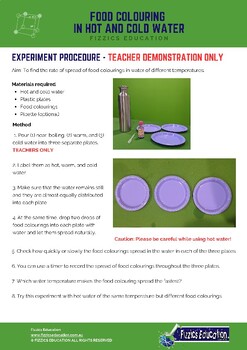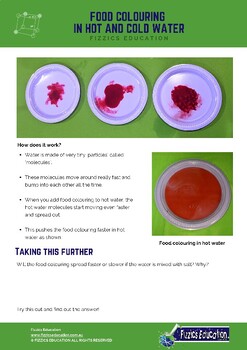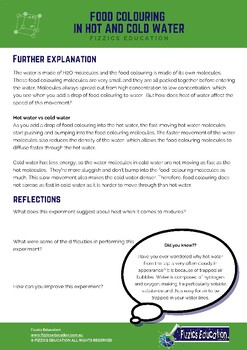Food colouring in hot and cold water - Teacher demonstration
Fizzics Education
9 Followers
Grade Levels
5th - 6th
Subjects
Resource Type
Standards
NGSS5-PS1-4
NGSSMS-PS1-4
NGSS5-PS1-1
NGSSMS-PS1-1
Formats Included
- PDF
- Easel Activity
- Easel Assessment
Pages
3 pages
Fizzics Education
9 Followers
Easel Activity Included
This resource includes a ready-to-use interactive activity students can complete on any device. Easel by TPT is free to use! Learn more.
Easel Assessment Included
This resource includes a self-grading quiz students can complete on any device. Easel by TPT is free to use! Learn more.
Description
- 3 sheets in total in A4 format
- Background information on the science experiment
- A list of the experiment materials needed (uses simple materials found in local shops, at home or in the classroom)
- The method on how to conduct the science experiment safely in your classroom (teacher demonstration only)
- Reflection sheet with questions that determine student understanding
Follow the Fizzics Education Teachers Pay Teachers Store :)
Going Further
School incursion hot and cold!
Have this award-winning school science incursion visit your school as either an on-site visit or interactive online program.
NB: The author is Australian and as such uses British English (BE) spelling
Total Pages
3 pages
Answer Key
N/A
Teaching Duration
30 minutes
Report this resource to TPT
Reported resources will be reviewed by our team. Report this resource to let us know if this resource violates TPT’s content guidelines.
Standards
to see state-specific standards (only available in the US).
NGSS5-PS1-4
Conduct an investigation to determine whether the mixing of two or more substances results in new substances.
NGSSMS-PS1-4
Develop a model that predicts and describes changes in particle motion, temperature, and state of a pure substance when thermal energy is added or removed. Emphasis is on qualitative molecular-level models of solids, liquids, and gases to show that adding or removing thermal energy increases or decreases kinetic energy of the particles until a change of state occurs. Examples of models could include drawings and diagrams. Examples of particles could include molecules or inert atoms. Examples of pure substances could include water, carbon dioxide, and helium.
NGSS5-PS1-1
Develop a model to describe that matter is made of particles too small to be seen. Examples of evidence could include adding air to expand a basketball, compressing air in a syringe, dissolving sugar in water, and evaporating salt water. Assessment does not include the atomic-scale mechanism of evaporation and condensation or defining the unseen particles.
NGSSMS-PS1-1
Develop models to describe the atomic composition of simple molecules and extended structures. Emphasis is on developing models of molecules that vary in complexity. Examples of simple molecules could include ammonia and methanol. Examples of extended structures could include sodium chloride or diamonds. Examples of molecular-level models could include drawings, 3D ball and stick structures, or computer representations showing different molecules with different types of atoms. Assessment does not include valence electrons and bonding energy, discussing the ionic nature of subunits of complex structures, or a complete depiction of all individual atoms in a complex molecule or extended structure.





